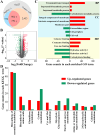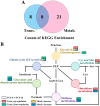A complex metabolic network and its biomarkers regulate laccase production in white-rot fungus Cerrena unicolor 87613
- PMID: 38849849
- PMCID: PMC11162070
- DOI: 10.1186/s12934-024-02443-9
A complex metabolic network and its biomarkers regulate laccase production in white-rot fungus Cerrena unicolor 87613
Erratum in
-
Correction: A complex metabolic network and its biomarkers regulate laccase production in white-rot fungus Cerrena unicolor 87613.Microb Cell Fact. 2024 Jul 15;23(1):197. doi: 10.1186/s12934-024-02458-2. Microb Cell Fact. 2024. PMID: 39004711 Free PMC article. No abstract available.
Abstract
Background: White-rot fungi are known to naturally produce high quantities of laccase, which exhibit commendable stability and catalytic efficiency. However, their laccase production does not meet the demands for industrial-scale applications. To address this limitation, it is crucial to optimize the conditions for laccase production. However, the regulatory mechanisms underlying different conditions remain unclear. This knowledge gap hinders the cost-effective application of laccases.
Results: In this study, we utilized transcriptomic and metabolomic data to investigate a promising laccase producer, Cerrena unicolor 87613, cultivated with fructose as the carbon source. Our comprehensive analysis of differentially expressed genes (DEGs) and differentially abundant metabolites (DAMs) aimed to identify changes in cellular processes that could affect laccase production. As a result, we discovered a complex metabolic network primarily involving carbon metabolism and amino acid metabolism, which exhibited contrasting changes between transcription and metabolic patterns. Within this network, we identified five biomarkers, including succinate, serine, methionine, glutamate and reduced glutathione, that played crucial roles in co-determining laccase production levels.
Conclusions: Our study proposed a complex metabolic network and identified key biomarkers that determine the production level of laccase in the commercially promising Cerrena unicolor 87613. These findings not only shed light on the regulatory mechanisms of carbon sources in laccase production, but also provide a theoretical foundation for enhancing laccase production through strategic reprogramming of metabolic pathways, especially related to the citrate cycle and specific amino acid metabolism.
Keywords: Cerrena unicolor; Fructose; Laccase production; Metabolic networks; Regulation mechanism; White rot fungi.
© 2024. The Author(s).
Conflict of interest statement
The authors declare no competing interests.
Figures








References
-
- Gao X, Wei M, Zhang X, Xun Y, Duan M, Yang Z, Zhu M, Zhu Y, Zhuo R. Copper removal from aqueous solutions by white rot fungus Pleurotus Ostreatus GEMB-PO1 and its potential in co-remediation of copper and organic pollutants. Bioresour Technol. 2024;395:130337. doi: 10.1016/j.biortech.2024.130337. - DOI - PubMed
-
- Chen L, Zhang X, Zhang M, Zhu YH, Zhou R. Removal of heavy-metal pollutants by white rot fungi: mechanisms, achievements, and perspectives. J Clean Prod. 2022;354:131681. doi: 10.1016/j.jclepro.2022.131681. - DOI
-
- Ziaja-Soltys M, Kolodziej P, Stefaniuk D, Matuszewska A, Jaszek M, Bogucka-Kocka A. Low-molecular-weight secondary metabolites from fungi: Cerrena Unicolor as a new proposal of an effective preparation against Rhabditis nematodes. Molecules. 2022;27:1660. doi: 10.3390/molecules27051660. - DOI - PMC - PubMed
MeSH terms
Substances
Grants and funding
LinkOut - more resources
Full Text Sources
Molecular Biology Databases
Research Materials
Miscellaneous

